warning JEEP WRANGLER UNLIMITED 2021 Owner handbook (in English)
[x] Cancel search | Manufacturer: JEEP, Model Year: 2021, Model line: WRANGLER UNLIMITED, Model: JEEP WRANGLER UNLIMITED 2021Pages: 330, PDF Size: 9.16 MB
Page 206 of 330
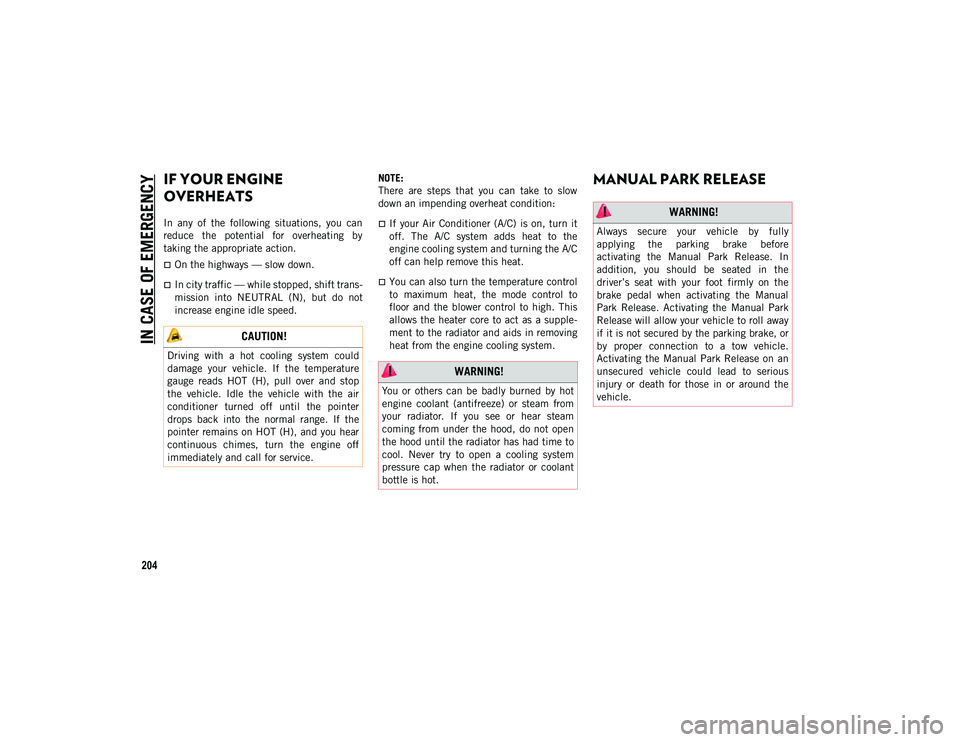
IN CASE OF EMERGENCY
204
IF YOUR ENGINE
OVERHEATS
In any of the following situations, you can
reduce the potential for overheating by
taking the appropriate action.
On the highways — slow down.
In city traffic — while stopped, shift trans-
mission into NEUTRAL (N), but do not
increase engine idle speed.NOTE:
There are steps that you can take to slow
down an impending overheat condition:
If your Air Conditioner (A/C) is on, turn it
off. The A/C system adds heat to the
engine cooling system and turning the A/C
off can help remove this heat.
You can also turn the temperature control
to maximum heat, the mode control to
floor and the blower control to high. This
allows the heater core to act as a supple-
ment to the radiator and aids in removing
heat from the engine cooling system.
MANUAL PARK RELEASE
CAUTION!
Driving with a hot cooling system could
damage your vehicle. If the temperature
gauge reads HOT (H), pull over and stop
the vehicle. Idle the vehicle with the air
conditioner turned off until the pointer
drops back into the normal range. If the
pointer remains on HOT (H), and you hear
continuous chimes, turn the engine off
immediately and call for service.
WARNING!
You or others can be badly burned by hot
engine coolant (antifreeze) or steam from
your radiator. If you see or hear steam
coming from under the hood, do not open
the hood until the radiator has had time to
cool. Never try to open a cooling system
pressure cap when the radiator or coolant
bottle is hot.
WARNING!
Always secure your vehicle by fully
applying the parking brake before
activating the Manual Park Release. In
addition, you should be seated in the
driver’s seat with your foot firmly on the
brake pedal when activating the Manual
Park Release. Activating the Manual Park
Release will allow your vehicle to roll away
if it is not secured by the parking brake, or
by proper connection to a tow vehicle.
Activating the Manual Park Release on an
unsecured vehicle could lead to serious
injury or death for those in or around the
vehicle.
2020_JEEP_JL_WRANGLER_UG_RHD_UK.book Page 204
Page 208 of 330
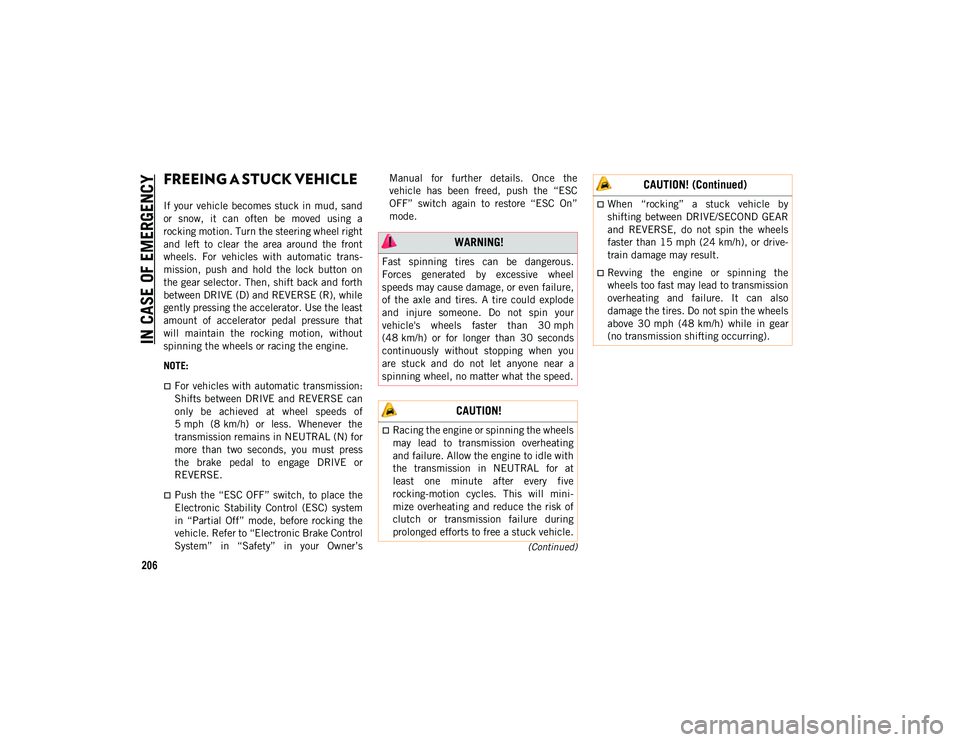
IN CASE OF EMERGENCY
206
(Continued)
FREEING A STUCK VEHICLE
If your vehicle becomes stuck in mud, sand
or snow, it can often be moved using a
rocking motion. Turn the steering wheel right
and left to clear the area around the front
wheels. For vehicles with automatic trans-
mission, push and hold the lock button on
the gear selector. Then, shift back and forth
between DRIVE (D) and REVERSE (R), while
gently pressing the accelerator. Use the least
amount of accelerator pedal pressure that
will maintain the rocking motion, without
spinning the wheels or racing the engine.
NOTE:
For vehicles with automatic transmission:
Shifts between DRIVE and REVERSE can
only be achieved at wheel speeds of
5 mph (8 km/h) or less. Whenever the
transmission remains in NEUTRAL (N) for
more than two seconds, you must press
the brake pedal to engage DRIVE or
REVERSE.
Push the “ESC OFF” switch, to place the
Electronic Stability Control (ESC) system
in “Partial Off” mode, before rocking the
vehicle. Refer to “Electronic Brake Control
System” in “Safety” in your Owner’s Manual for further details. Once the
vehicle has been freed, push the “ESC
OFF” switch again to restore “ESC On”
mode.
WARNING!
Fast spinning tires can be dangerous.
Forces generated by excessive wheel
speeds may cause damage, or even failure,
of the axle and tires. A tire could explode
and injure someone. Do not spin your
vehicle's wheels faster than 30 mph
(48 km/h) or for longer than 30 seconds
continuously without stopping when you
are stuck and do not let anyone near a
spinning wheel, no matter what the speed.
CAUTION!
Racing the engine or spinning the wheels
may lead to transmission overheating
and failure. Allow the engine to idle with
the transmission in NEUTRAL for at
least one minute after every five
rocking-motion cycles. This will mini
-
mize overheating and reduce the risk of
clutch or transmission failure during
prolonged efforts to free a stuck vehicle.
When “rocking” a stuck vehicle by
shifting between DRIVE/SECOND GEAR
and REVERSE, do not spin the wheels
faster than 15 mph (24 km/h), or drive -
train damage may result.
Revving the engine or spinning the
wheels too fast may lead to transmission
overheating and failure. It can also
damage the tires. Do not spin the wheels
above 30 mph (48 km/h) while in gear
(no transmission shifting occurring).
CAUTION! (Continued)
2020_JEEP_JL_WRANGLER_UG_RHD_UK.book Page 206
Page 210 of 330
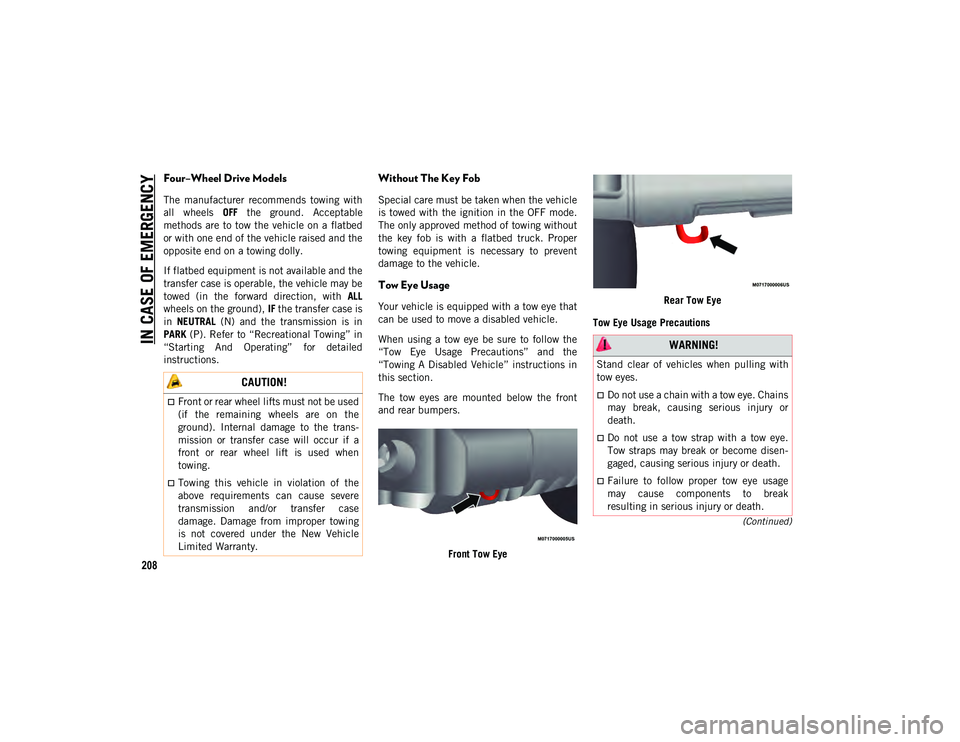
IN CASE OF EMERGENCY
208
(Continued)
Four–Wheel Drive Models
The manufacturer recommends towing with
all wheels OFF the ground. Acceptable
methods are to tow the vehicle on a flatbed
or with one end of the vehicle raised and the
opposite end on a towing dolly.
If flatbed equipment is not available and the
transfer case is operable, the vehicle may be
towed (in the forward direction, with ALL
wheels on the ground), IF the transfer case is
in NEUTRAL (N) and the transmission is in
PARK (P). Refer to “Recreational Towing” in
“Starting And Operating” for detailed
instructions.
Without The Key Fob
Special care must be taken when the vehicle
is towed with the ignition in the OFF mode.
The only approved method of towing without
the key fob is with a flatbed truck. Proper
towing equipment is necessary to prevent
damage to the vehicle.
Tow Eye Usage
Your vehicle is equipped with a tow eye that
can be used to move a disabled vehicle.
When using a tow eye be sure to follow the
“Tow Eye Usage Precautions” and the
“Towing A Disabled Vehicle” instructions in
this section.
The tow eyes are mounted below the front
and rear bumpers.
Front Tow Eye Rear Tow Eye
Tow Eye Usage Precautions
CAUTION!
Front or rear wheel lifts must not be used
(if the remaining wheels are on the
ground). Internal damage to the trans-
mission or transfer case will occur if a
front or rear wheel lift is used when
towing.
Towing this vehicle in violation of the
above requirements can cause severe
transmission and/or transfer case
damage. Damage from improper towing
is not covered under the New Vehicle
Limited Warranty.
WARNING!
Stand clear of vehicles when pulling with
tow eyes.
Do not use a chain with a tow eye. Chains
may break, causing serious injury or
death.
Do not use a tow strap with a tow eye.
Tow straps may break or become disen -
gaged, causing serious injury or death.
Failure to follow proper tow eye usage
may cause components to break
resulting in serious injury or death.
2020_JEEP_JL_WRANGLER_UG_RHD_UK.book Page 208
Page 211 of 330
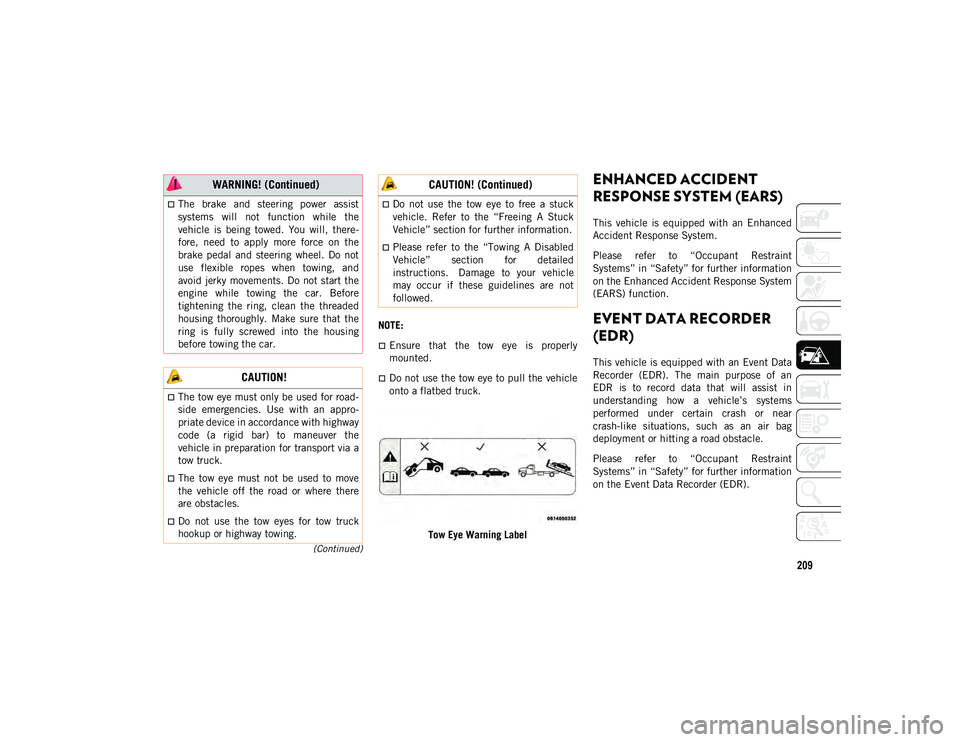
209
(Continued)
NOTE:
Ensure that the tow eye is properly
mounted.
Do not use the tow eye to pull the vehicle
onto a flatbed truck.Tow Eye Warning Label
ENHANCED ACCIDENT
RESPONSE SYSTEM (EARS)
This vehicle is equipped with an Enhanced
Accident Response System.
Please refer to “Occupant Restraint
Systems” in “Safety” for further information
on the Enhanced Accident Response System
(EARS) function.
EVENT DATA RECORDER
(EDR)
This vehicle is equipped with an Event Data
Recorder (EDR). The main purpose of an
EDR is to record data that will assist in
understanding how a vehicle’s systems
performed under certain crash or near
crash-like situations, such as an air bag
deployment or hitting a road obstacle.
Please refer to “Occupant Restraint
Systems” in “Safety” for further information
on the Event Data Recorder (EDR).
The brake and steering power assist
systems will not function while the
vehicle is being towed. You will, there-
fore, need to apply more force on the
brake pedal and steering wheel. Do not
use flexible ropes when towing, and
avoid jerky movements. Do not start the
engine while towing the car. Before
tightening the ring, clean the threaded
housing thoroughly. Make sure that the
ring is fully screwed into the housing
before towing the car.
CAUTION!
The tow eye must only be used for road -
side emergencies. Use with an appro-
priate device in accordance with highway
code (a rigid bar) to maneuver the
vehicle in preparation for transport via a
tow truck.
The tow eye must not be used to move
the vehicle off the road or where there
are obstacles.
Do not use the tow eyes for tow truck
hookup or highway towing.
WARNING! (Continued)
Do not use the tow eye to free a stuck
vehicle. Refer to the “Freeing A Stuck
Vehicle” section for further information.
Please refer to the “Towing A Disabled
Vehicle” section for detailed
instructions. Damage to your vehicle
may occur if these guidelines are not
followed.
CAUTION! (Continued)
2020_JEEP_JL_WRANGLER_UG_RHD_UK.book Page 209
Page 218 of 330
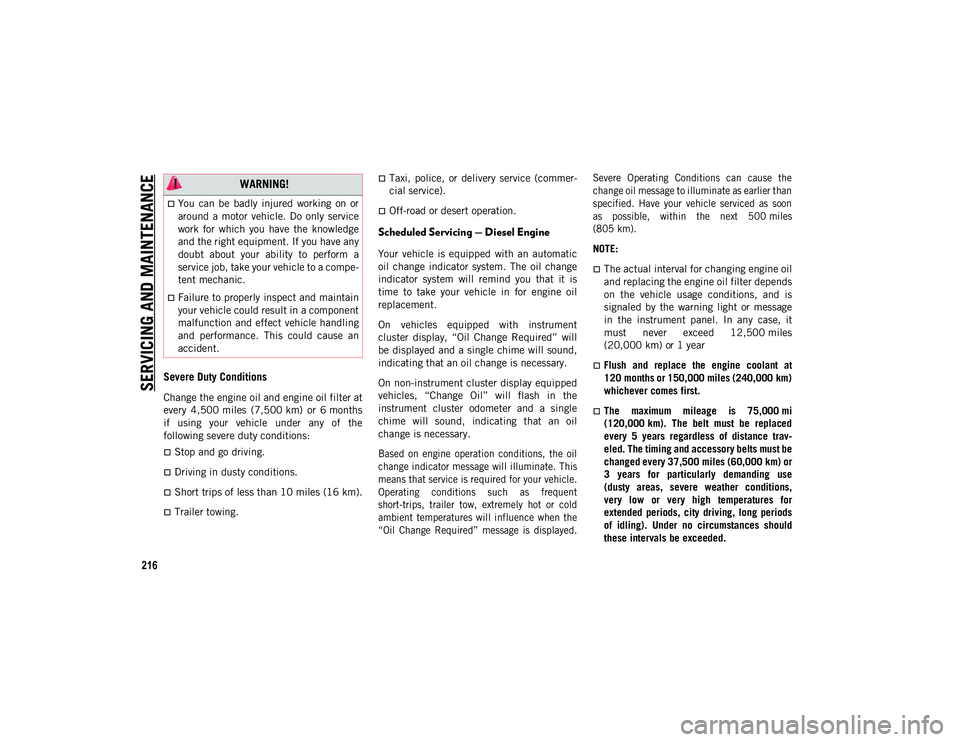
SERVICING AND MAINTENANCE
216
Severe Duty Conditions
Change the engine oil and engine oil filter at
every 4,500 miles (7,500 km) or 6 months
if using your vehicle under any of the
following severe duty conditions:
Stop and go driving.
Driving in dusty conditions.
Short trips of less than 10 miles (16 km).
Trailer towing.
Taxi, police, or delivery service (commer-
cial service).
Off-road or desert operation.
Scheduled Servicing — Diesel Engine
Your vehicle is equipped with an automatic
oil change indicator system. The oil change
indicator system will remind you that it is
time to take your vehicle in for engine oil
replacement.
On vehicles equipped with instrument
cluster display, “Oil Change Required” will
be displayed and a single chime will sound,
indicating that an oil change is necessary.
On non-instrument cluster display equipped
vehicles, “Change Oil” will flash in the
instrument cluster odometer and a single
chime will sound, indicating that an oil
change is necessary.
Based on engine operation conditions, the oil
change indicator message will illuminate. This
means that service is required for your vehicle.
Operating conditions such as frequent
short-trips, trailer tow, extremely hot or cold
ambient temperatures will influence when the
“Oil Change Required” message is displayed. Severe Operating Conditions can cause the
change oil message to illuminate as earlier than
specified. Have your vehicle serviced as soon
as possible, within the next 500 miles
(805 km).
NOTE:
The actual interval for changing engine oil
and replacing the engine oil filter depends
on the vehicle usage conditions, and is
signaled by the warning light or message
in the instrument panel. In any case, it
must never exceed 12,500 miles
(20,000 km) or 1 year
Flush and replace the engine coolant at
120 months or 150,000 miles (240,000 km)
whichever comes first.
The maximum mileage is 75,000 mi
(120,000 km). The belt must be replaced
every 5 years regardless of distance trav-
eled. The timing and accessory belts must be
changed every 37,500 miles (60,000 km) or
3 years for particularly demanding use
(dusty areas, severe weather conditions,
very low or very high temperatures for
extended periods, city driving, long periods
of idling). Under no circumstances should
these intervals be exceeded.
WARNING!
You can be badly injured working on or
around a motor vehicle. Do only service
work for which you have the knowledge
and the right equipment. If you have any
doubt about your ability to perform a
service job, take your vehicle to a compe-
tent mechanic.
Failure to properly inspect and maintain
your vehicle could result in a component
malfunction and effect vehicle handling
and performance. This could cause an
accident.
2020_JEEP_JL_WRANGLER_UG_RHD_UK.book Page 216
Page 222 of 330
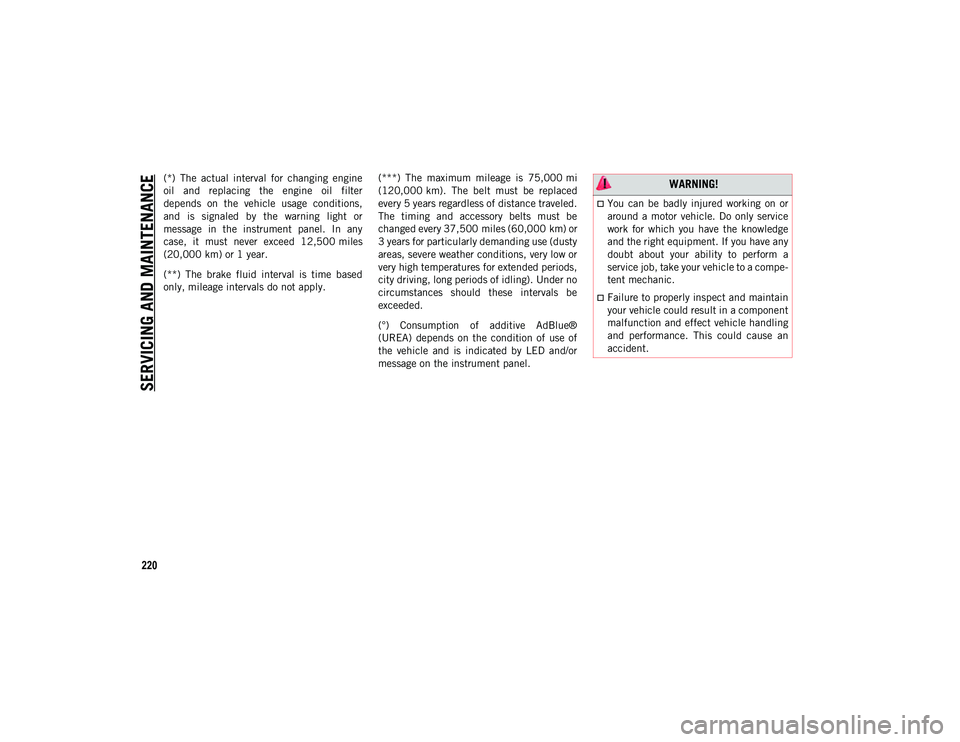
SERVICING AND MAINTENANCE
220
(*) The actual interval for changing engine
oil and replacing the engine oil filter
depends on the vehicle usage conditions,
and is signaled by the warning light or
message in the instrument panel. In any
case, it must never exceed 12,500 miles
(20,000 km) or 1 year.
(**) The brake fluid interval is time based
only, mileage intervals do not apply.(***) The maximum mileage is 75,000 mi
(120,000 km). The belt must be replaced
every 5 years regardless of distance traveled.
The timing and accessory belts must be
changed every 37,500 miles (60,000 km) or
3 years for particularly demanding use (dusty
areas, severe weather conditions, very low or
very high temperatures for extended periods,
city driving, long periods of idling). Under no
circumstances should these intervals be
exceeded.
(°) Consumption of additive AdBlue®
(UREA) depends on the condition of use of
the vehicle and is indicated by LED and/or
message on the instrument panel. WARNING!
You can be badly injured working on or
around a motor vehicle. Do only service
work for which you have the knowledge
and the right equipment. If you have any
doubt about your ability to perform a
service job, take your vehicle to a compe-
tent mechanic.
Failure to properly inspect and maintain
your vehicle could result in a component
malfunction and effect vehicle handling
and performance. This could cause an
accident.
2020_JEEP_JL_WRANGLER_UG_RHD_UK.book Page 220
Page 226 of 330
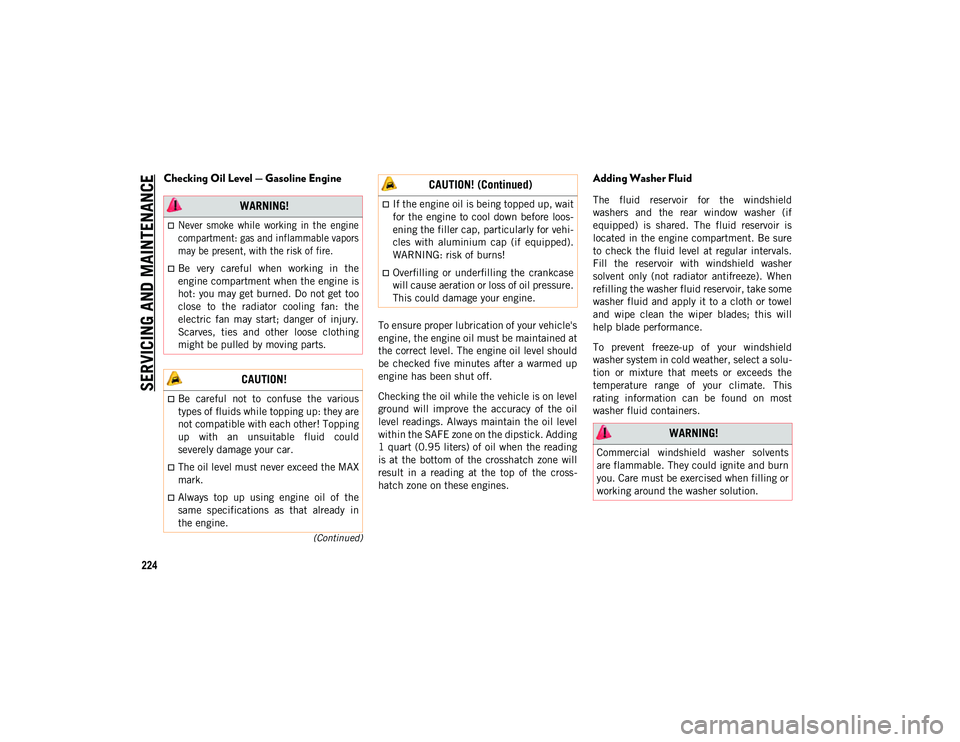
SERVICING AND MAINTENANCE
224
(Continued)
Checking Oil Level — Gasoline Engine
To ensure proper lubrication of your vehicle's
engine, the engine oil must be maintained at
the correct level. The engine oil level should
be checked five minutes after a warmed up
engine has been shut off.
Checking the oil while the vehicle is on level
ground will improve the accuracy of the oil
level readings. Always maintain the oil level
within the SAFE zone on the dipstick. Adding
1 quart (0.95 liters) of oil when the reading
is at the bottom of the crosshatch zone will
result in a reading at the top of the cross-
hatch zone on these engines.
Adding Washer Fluid
The fluid reservoir for the windshield
washers and the rear window washer (if
equipped) is shared. The fluid reservoir is
located in the engine compartment. Be sure
to check the fluid level at regular intervals.
Fill the reservoir with windshield washer
solvent only (not radiator antifreeze). When
refilling the washer fluid reservoir, take some
washer fluid and apply it to a cloth or towel
and wipe clean the wiper blades; this will
help blade performance.
To prevent freeze-up of your windshield
washer system in cold weather, select a solu -
tion or mixture that meets or exceeds the
temperature range of your climate. This
rating information can be found on most
washer fluid containers. WARNING!
Never smoke while working in the engine
compartment: gas and inflammable vapors
may be present, with the risk of fire.
Be very careful when working in the
engine compartment when the engine is
hot: you may get burned. Do not get too
close to the radiator cooling fan: the
electric fan may start; danger of injury.
Scarves, ties and other loose clothing
might be pulled by moving parts.
CAUTION!
Be careful not to confuse the various
types of fluids while topping up: they are
not compatible with each other! Topping
up with an unsuitable fluid could
severely damage your car.
The oil level must never exceed the MAX
mark.
Always top up using engine oil of the
same specifications as that already in
the engine.
If the engine oil is being topped up, wait
for the engine to cool down before loos-
ening the filler cap, particularly for vehi -
cles with aluminium cap (if equipped).
WARNING: risk of burns!
Overfilling or underfilling the crankcase
will cause aeration or loss of oil pressure.
This could damage your engine.
CAUTION! (Continued)
WARNING!
Commercial windshield washer solvents
are flammable. They could ignite and burn
you. Care must be exercised when filling or
working around the washer solution.
2020_JEEP_JL_WRANGLER_UG_RHD_UK.book Page 224
Page 227 of 330
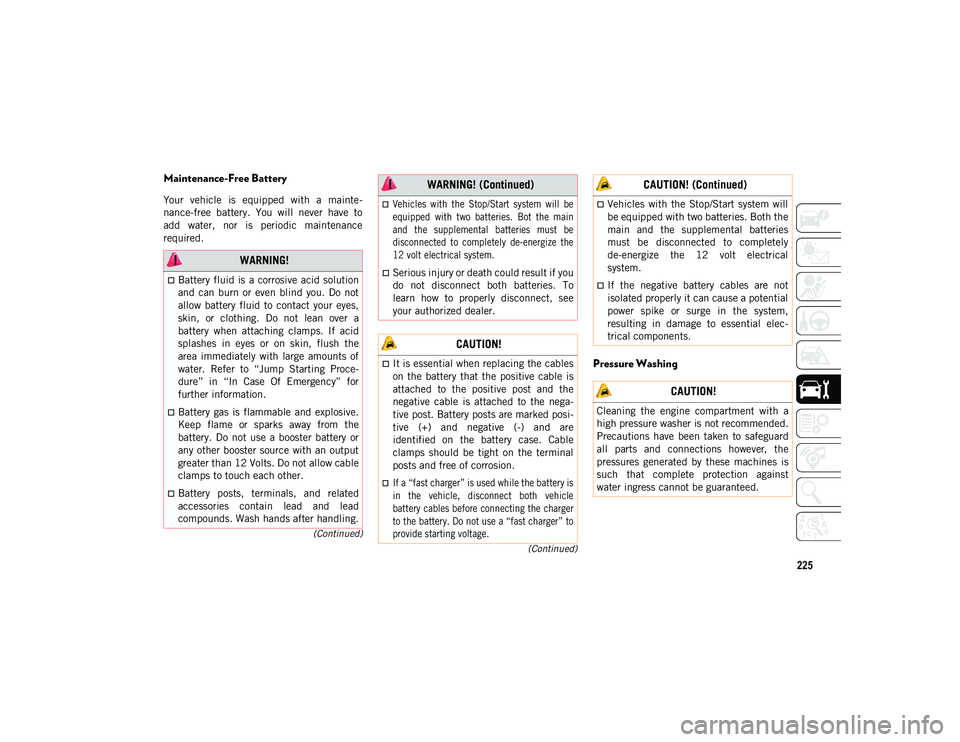
225
(Continued)
(Continued)
Maintenance-Free Battery
Your vehicle is equipped with a mainte
-
nance-free battery. You will never have to
add water, nor is periodic maintenance
required.
Pressure Washing
WARNING!
Battery fluid is a corrosive acid solution
and can burn or even blind you. Do not
allow battery fluid to contact your eyes,
skin, or clothing. Do not lean over a
battery when attaching clamps. If acid
splashes in eyes or on skin, flush the
area immediately with large amounts of
water. Refer to “Jump Starting Proce-
dure” in “In Case Of Emergency” for
further information.
Battery gas is flammable and explosive.
Keep flame or sparks away from the
battery. Do not use a booster battery or
any other booster source with an output
greater than 12 Volts. Do not allow cable
clamps to touch each other.
Battery posts, terminals, and related
accessories contain lead and lead
compounds. Wash hands after handling.
Vehicles with the Stop/Start system will be
equipped with two batteries. Bot the main
and the supplemental batteries must be
disconnected to completely de-energize the
12 volt electrical system.
Serious injury or death could result if you
do not disconnect both batteries. To
learn how to properly disconnect, see
your authorized dealer.
CAUTION!
It is essential when replacing the cables
on the battery that the positive cable is
attached to the positive post and the
negative cable is attached to the nega-
tive post. Battery posts are marked posi -
tive (+) and negative (-) and are
identified on the battery case. Cable
clamps should be tight on the terminal
posts and free of corrosion.
If a “fast charger” is used while the battery is
in the vehicle, disconnect both vehicle
battery cables before connecting the charger
to the battery. Do not use a “fast charger” to
provide starting voltage.
WARNING! (Continued)
Vehicles with the Stop/Start system will
be equipped with two batteries. Both the
main and the supplemental batteries
must be disconnected to completely
de-energize the 12 volt electrical
system.
If the negative battery cables are not
isolated properly it can cause a potential
power spike or surge in the system,
resulting in damage to essential elec-
trical components.
CAUTION!
Cleaning the engine compartment with a
high pressure washer is not recommended.
Precautions have been taken to safeguard
all parts and connections however, the
pressures generated by these machines is
such that complete protection against
water ingress cannot be guaranteed.
CAUTION! (Continued)
2020_JEEP_JL_WRANGLER_UG_RHD_UK.book Page 225
Page 228 of 330
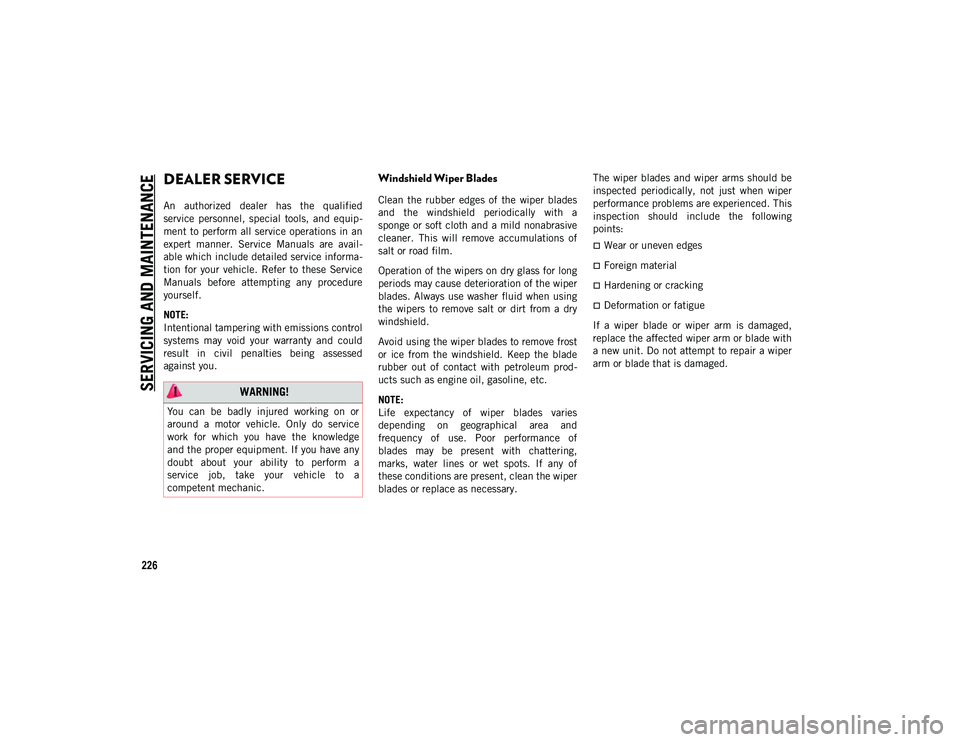
SERVICING AND MAINTENANCE
226
DEALER SERVICE
An authorized dealer has the qualified
service personnel, special tools, and equip-
ment to perform all service operations in an
expert manner. Service Manuals are avail -
able which include detailed service informa -
tion for your vehicle. Refer to these Service
Manuals before attempting any procedure
yourself.
NOTE:
Intentional tampering with emissions control
systems may void your warranty and could
result in civil penalties being assessed
against you.
Windshield Wiper Blades
Clean the rubber edges of the wiper blades
and the windshield periodically with a
sponge or soft cloth and a mild nonabrasive
cleaner. This will remove accumulations of
salt or road film.
Operation of the wipers on dry glass for long
periods may cause deterioration of the wiper
blades. Always use washer fluid when using
the wipers to remove salt or dirt from a dry
windshield.
Avoid using the wiper blades to remove frost
or ice from the windshield. Keep the blade
rubber out of contact with petroleum prod -
ucts such as engine oil, gasoline, etc.
NOTE:
Life expectancy of wiper blades varies
depending on geographical area and
frequency of use. Poor performance of
blades may be present with chattering,
marks, water lines or wet spots. If any of
these conditions are present, clean the wiper
blades or replace as necessary. The wiper blades and wiper arms should be
inspected periodically, not just when wiper
performance problems are experienced. This
inspection should include the following
points:
Wear or uneven edges
Foreign material
Hardening or cracking
Deformation or fatigue
If a wiper blade or wiper arm is damaged,
replace the affected wiper arm or blade with
a new unit. Do not attempt to repair a wiper
arm or blade that is damaged.
WARNING!
You can be badly injured working on or
around a motor vehicle. Only do service
work for which you have the knowledge
and the proper equipment. If you have any
doubt about your ability to perform a
service job, take your vehicle to a
competent mechanic.
2020_JEEP_JL_WRANGLER_UG_RHD_UK.book Page 226
Page 230 of 330
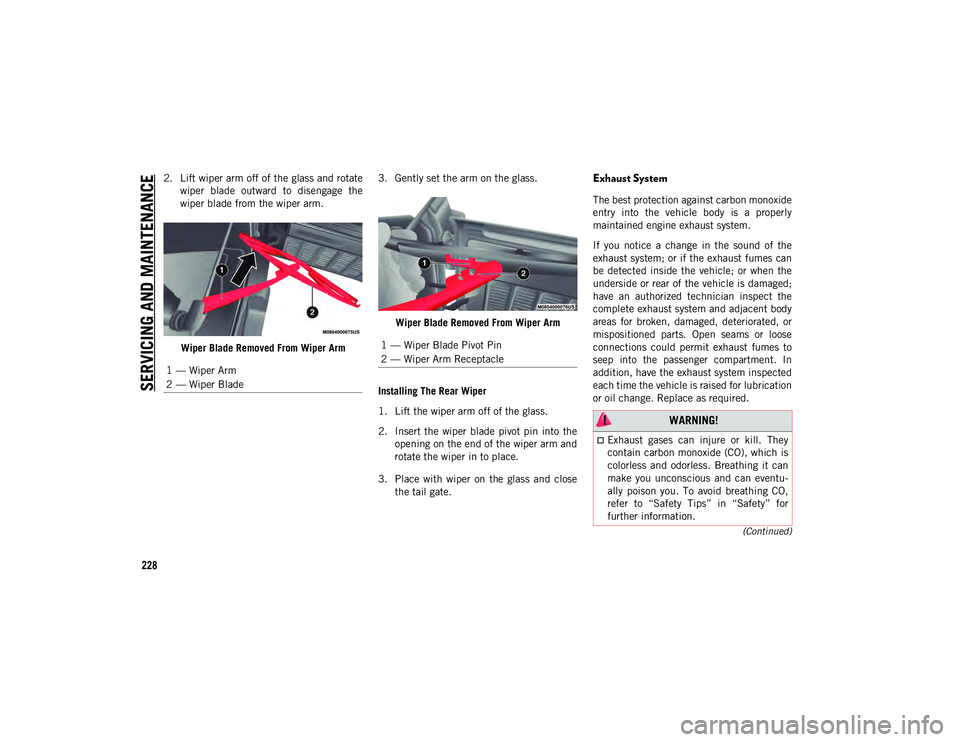
SERVICING AND MAINTENANCE
228
(Continued)
2. Lift wiper arm off of the glass and rotatewiper blade outward to disengage the
wiper blade from the wiper arm.
Wiper Blade Removed From Wiper Arm 3. Gently set the arm on the glass.
Wiper Blade Removed From Wiper Arm
Installing The Rear Wiper
1. Lift the wiper arm off of the glass.
2. Insert the wiper blade pivot pin into the opening on the end of the wiper arm and
rotate the wiper in to place.
3. Place with wiper on the glass and close the tail gate.Exhaust System
The best protection against carbon monoxide
entry into the vehicle body is a properly
maintained engine exhaust system.
If you notice a change in the sound of the
exhaust system; or if the exhaust fumes can
be detected inside the vehicle; or when the
underside or rear of the vehicle is damaged;
have an authorized technician inspect the
complete exhaust system and adjacent body
areas for broken, damaged, deteriorated, or
mispositioned parts. Open seams or loose
connections could permit exhaust fumes to
seep into the passenger compartment. In
addition, have the exhaust system inspected
each time the vehicle is raised for lubrication
or oil change. Replace as required.
1 — Wiper Arm
2 — Wiper Blade
1 — Wiper Blade Pivot Pin
2 — Wiper Arm Receptacle
WARNING!
Exhaust gases can injure or kill. They
contain carbon monoxide (CO), which is
colorless and odorless. Breathing it can
make you unconscious and can eventu
-
ally poison you. To avoid breathing CO,
refer to “Safety Tips” in “Safety” for
further information.
2020_JEEP_JL_WRANGLER_UG_RHD_UK.book Page 228